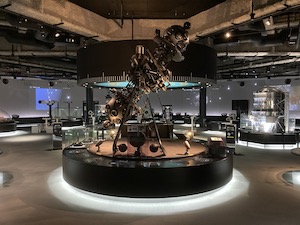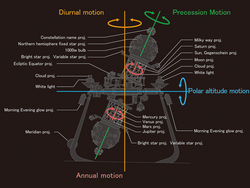Nagoya City Science Museum
TOP > Exhibition Guide > Floor Map> ZEISS Mark IV Planetarium
ZEISS Mark IV Planetarium

Purpose of Exhibition
The Zeiss Mark IV planetarium projector was installed on November 3, 1962, with the opening of the Nagoya City Science Museum. Since then, it had worked in the 20m dome of the former Astronomy Building until August 31, 2010. It was retired from star projection in the dome along with the renovation of the museum, and has been moved to this gallery, still kept in good enough condition to operate. The control panel and the auxiliary projectors have also been relocated and rewired. As such, the Mark IV still holds almost all its original functions after the renovation until now.
You can walk around and get a look at the main unit and control panel much closer than when it was in service. For occasional public talks, it casts a part of the sky on the wall of this gallery, which you can compare with the image projected by its replacement the UNIVERSARIUM Mark IX in the sixth floor dome.
The elaborate wheelworks behind the Mark IV projector had exquisitely reproduced how the starry sky works.


Additional Knowledge
When and who built the first modern planetarium? How does it work?
[Who Invented the Planetarium Projector?]
It was Walther Bauersfeld, an engineer at Carl Zeiss in Germany, who invented the planetarium in the modern sense of the word. In response to a request from the Deutsches Museum (German Museum) to depict how the solar system and the starry sky work, Carl Zeiss designed two planetariums. One is a “Copernican” planetarium: a light bulb was installed in the center of a cylindrical room as the sun, and the planets rotated around it. Visitors also rode around “the sun” on a cart placed in the orbit of the earth. This design allows visitors to see the astronomically correct changes in the position of the planets relative to the stars, but it turned out to be not as successful as the other.
The other is the “geocentric” planetarium: a projector was set in the center of the dome, and cast stars and planets inside the dome. This has eventually evolved into the modern planetariums. In 1923, on the rooftop of the Carl Zeiss factory in Jena, Germany, people for the first time enjoyed the night sky in the daytime. The first unit was installed at the Deutsches Museum in 1925 and served until 1964. One was shipped to Japan in 1937 and housed in Japan’s first planetarium, formerly known as the Osaka City Electricity Science Museum.
[How Planetarium Projectors Work]
The Zeiss Mark IV was set up at the Nagoya City Science Museum in 1962. Without any computers, this projector realizes all of its functions via movements, such as cams and rods, gears, linkages, electrical switches and knobs. Each and every single motion of the projector is directly connected to the switches and knobs on the console on exhibit. In other words, in the former planetarium, we had operated the Zeiss Mark IV entirely manually.
You can see in the diagram which switch each function is connected to.
This page was last edited on 8 July 2022.
Article by Astronomy Section
